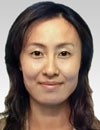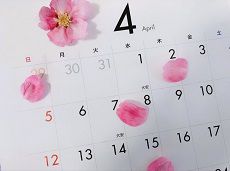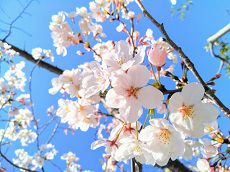The Japanese fiscal year
The Japanese financial or fiscal year spans from April 1st to March 31st . Schools and businesses usually follow this calendar to mark the start of a new year and hold ceremonies to celebrate the new additions to their institutions.
It also takes place during the start of spring, so in Japan spring is often seen at the season for new beginnings.
In this blog for Japanese learners, Ms. Noriko Yokozuka, a Japanese teacher at JOI, introduces this new fiscal year topic and explains it from a native Japanese person's viewpoint. It is a good way to learn Japanese by reading the blog and memorizing new Kanji or vocabulary too.
She also includes several key words and phrases that a part of the JLPT examination curriculum.
Listen to the video and practice some Japanese listening as well.
新年度の始まりによせて
The fiscal year begins

By YOKOZUKA Noriko

4月は入学式や入社式など、新しい生活がスタートする時期です。満開の桜の木の下で入学式の記念写真を撮るというイメージが強い時期ですが、今年は桜が咲くのがとても早いですね。このブログを書いているのは3月30日ですが、今日のこの時点で、私が住んでいるところではすでに散り始めています。桜の花びらがひらひらと風に舞う様子はとても美しく、思わず立ち止まって見とれてしまいます。
日本の年度は、そのような桜の美しい時から始まります(もちろん地域差はありますが)。一般的には4月1日から翌年3月31日までが一つの年度になります。今年度は、2020年(令和2年)4月1日~2021年(令和3年)3月31日まで、「2020年度」あるいは「令和2年度」と呼ばれる年度になります。
学校などは、海外に倣って9月始まりにしようという意見もあるようですが、おそらくその意見は少数派でしょう。桜のイメージとともにある新年度の始まりは、なかなか変えがたいものだろうと思います。
桜が舞い散る様子を眺めながら安らかな気持ちで新年度を迎え、世の中が大変な時ではありますが、たくさんの人々が、少しでも穏やかな日常を送れるようにと願っています。

To listen to this blog, please watch our Youtube video.
新年度(しんねんど)の始(はじ)まりによせて
4月は入学式(にゅうがくしき)や入社式(にゅうしゃしき)など、新(あたら)しい生活(せいかつ)がスタートする時期(じき)です。満開(まんかい)の桜(さくら)の木(き)の下(した)で入学式の記念写真(きねんしゃしん)を撮(と)るというイメージが強(つよ)い時期(じき)ですが、今年(ことし)は桜が咲(さ)くのがとても早(はや)いですね。このブログを書いているのは3月30日ですが、今日のこの時点(じてん)で、私(わたし)が住(す)んでいるところではすでに散(ち)り始(はじ)めています。桜の花(はな)びらがひらひらと風(かぜ)に舞(ま)う様子(ようす)はとても美(うつく)しく、思(おも)わず立(た)ち止(ど)まって見とれてしまいます。
日本の年度は、そのような桜の美(うつく)しい時(とき)から始まります(もちろん地域差(ちいきさ)はありますが)。一般的(いっぱんてき)には4月1日から翌年(よくねん)3月31日までが一つの年度になります。今年度(こんねんど)は、2020年(令和(れいわ)2年)4月1日~2021年(令和3年)3月31日まで、「2020年度」あるいは「令和2年度」と呼(よ)ばれる年度になります。
学校(がっこう)などは、海外(かいがい)に倣(なら)って9月始まりにしようという意見(いけん)もあるようですが、おそらくその意見は少数派(しょうすうは)でしょう。桜のイメージとともにある新年度の始まりは、なかなか変(か)えがたいものだろうと思(おも)います。
桜が舞(ま)い散(ち)る様子(ようす)を眺(なが)めながら安(やす)らかな気持(きも)ちで新年度を迎(むか)え、世(よ)の中(なか)が大変(たいへん)な時ではありますが、たくさんの人々(ひとびと)が、少(すこ)しでも穏(おだ)やかな日常(にちじょう)を送(おく)れるようにと願(ねが)っています。
The fiscal year begins
April is the season for schools' and companies' entrance ceremonies and the start of a new life. This season holds a strong image of taking commemorative photographs under a fully bloomed cherry blossom tree in people's minds but this year's cherry blossom blooming has been rather early hasn't it. I am writing this blog on March 30th but at this point in the place where I live, the petals have begun to fall. The sight of the flower petals falling lightly on the breeze is very beautiful and I find myself stopping to watch in fascination.
The Japanese academic and financial year starts in this way at a time when the cherry blossoms are beautiful (of course there are differences between areas). One fiscal year generally spans from April 1st up to the following year's March 31st . This year starts from April 1st 2020 or Reiwa 2, until March 31st 2021 or Reiwa 3 and it will be known as the 2020 fiscal year or the Reiwa 2 fiscal year.
There is an opinion to change the start of the academic year to September to align with the international standard but those who hold that opinion are probably a minority faction.
The world is now in a difficult time but I hope that a lot of people can welcome the new year by tranquilly watching the fluttering fall of cherry blossom petals and I hope that they can spend their daily lives a little more peacefully by doing so.
年度 ねんど:the year
ひらひら:軽くて薄いものが揺れて動く様子。 The movement seen when something scatters lightly and thinly over a surface
見とれる be fascinated 《by》、watch something in fascination、be charmed 《by》、be struck 《by》、look admiringly 《at》、be lost in admiration
倣う ならう:follow、conform to、follow、take after、emulate
少数派 しょうすうは:the minority faction
舞い散る まいちる:fluttering down

Konnichi-wa, everybody. I am originally from Ringo-no-ri in Aomori prefecture, but I am now living in Kakaa-tenka in Gunma prefecture. I've lived in several other of Japan's prefectures as well, including Niigata (which has gorgeous sunsets), Tochigi (where the Nikko Toshogu shrine is located), and Gifu (land of the famous Shirakawa-go area of historic rafter roofed houses).
I myself am studying Chinese, so I can really relate to the difficulty of learning a foreign language. But still, if we can get past that step and feel the excitement of having just a single word understood, the feeling of satisfaction that comes from communication is, no pun intended, beyond words. I'd like to invite everyone who visits our online Japanese school with the thought "I want to speak Japanese!" to join my classes. Until the day when you can say confidently, "I did it, I learned how to speak Japanese!", I promise to do my best to help you in your Japanese language studies.